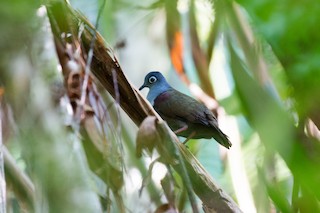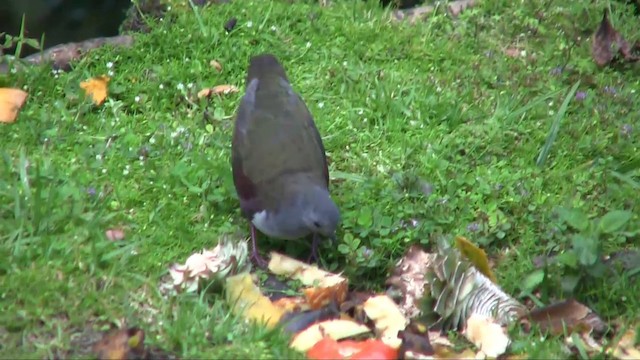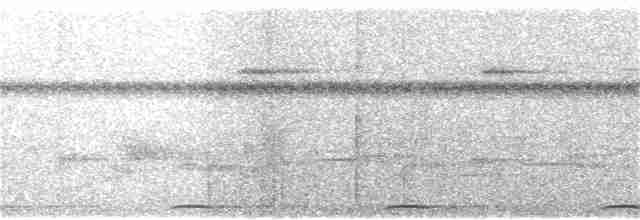Bronze Ground Dove Pampusana beccarii Scientific name definitions
Revision Notes
Sign in to see your badges
Species names in all available languages
| Language | Common name |
|---|---|
| Bulgarian | Бронзова земна гургулица |
| Catalan | colom de Beccari |
| Croatian | brončani golub |
| Czech | holub šedoprsý |
| Dutch | Grijsborstpatrijsduif |
| English | Bronze Ground Dove |
| English (United States) | Bronze Ground Dove |
| Estonian | väike-maatuvi |
| Finnish | pronssipyykyyhky |
| French | Gallicolombe de Beccari |
| French (Canada) | Gallicolombe de Beccari |
| German | Graubrusttaube |
| Indonesian | Delimukan beccari |
| Japanese | ハイムネバト |
| Norwegian | blåjorddue |
| Polish | wyspiarek papuaski |
| Russian | Серогрудый куриный голубь |
| Serbian | Bronzani golubić sa tla |
| Slovak | holubček sivoprsý |
| Spanish | Paloma Perdiz Pechigrís |
| Spanish (Spain) | Paloma perdiz pechigrís |
| Swedish | gråbröstad markduva |
| Turkish | Gri Göğüslü Yer Kumrusu |
| Ukrainian | Голуб новогвінейський |
Revision Notes
Leo Gilman prepared the account for the 2023 Clements taxonomy update.
Pampusana beccarii (Salvadori, 1876)
Definitions
- PAMPUSANA
- beccariana / beccarianus / beccarii
The Key to Scientific Names
Legend Overview
Introduction
Taxonomic note: Lump. This account is a combination of multiple species accounts originally published in HBW Alive. That content has been combined and labeled here at the subspecies level. Moving forward we will create a more unified account for this parent taxon. Please consider contributing your expertise to update this account.
Field Identification
Bronze Ground Dove (Western)
18–20 cm; male 84–104 g, female 59 g. Forehead and area above and behind eyes dark blue-gray becoming dark iridescent green on crown and nape, pale gray on breast and lower breast and grayish white on rear edge of breast shield; border of breast shield tipped purple at sides and blackish purple on lower breast; rest of underparts blackish gray; hindneck, upperparts , central tail feathers, median and greater wing-coverts, and inner secondaries dark olive-green with bronzy green gloss; lesser wing-coverts dark purple ; primaries and outer secondaries black; outer tail feathers dark gray with poorly defined black subterminal bands and brownish tips; iris brown, orbital skin creamy white; bill black, feet and legs purplish red. Female has dark gray head and upper breast, rest of underparts dull yellowish brown; gray of head and neck suffused brown; lacks purple on wings and sides of breast. Juvenile similar to female, but duller and browner, with rufous fringes to feathers of wings and breast, and to a lesser extent elsewhere.
Bronze Ground Dove (Eastern)
19 cm. Small, plump ground-dove. Adult male has pale ash-gray head, neck and breast, becoming paler on lower breast and has sharply contrasting black belly-band, dark rufous-brown mantle and wings, glossed bronze-green or maroon on lesser wing-coverts; outer tail has bright rufous terminal band and blackish subterminal bar. Female duller and browner, especially on breast, with dark gray upper breast merging into rufous lower breast, and lacks maroon on wing-coverts. Juvenile uniform warm brown, without gray, with rusty-orange fringes to wing-coverts, and chestnut fringes to breast and belly feathers. Nominate johannae is comparatively large, with upperparts of male glossed bronzy purple and brown plumage paler and redder; the white eye-ring is particularly broad and conspicuous in New Britain population of johannae (1); admiralitatis similar, but has head entirely blue-gray and breast shield becomes white only at median part of border, whereas female has fairly clearly demarcated dark gray breast shield; eichhorni is slightly smaller and male has white eyering and paler breast; masculinus has paler gray-brown lower breast and belly, and no pale eyering, while female is similar but lacks purple on lesser coverts and has ill-defined lower border to gray breast; intermedius has darker, more purplish-bronze belly; and solomonensis has slightly bronzier upperparts. Foraging birds appear very compact and round, and often hold tail cocked. Long legs and rather fast, erratic progression create a rail-like impression (1).
Systematics History
Editor's Note: This article requires further editing work to merge existing content into the appropriate Subspecies sections. Please bear with us while this update takes place.
Bronze Ground Dove (Western)
Hitherto considered conspecific with A. johannae, but here separated on account of rather grayer belly (with resultant dark brownish lower breastband) vs dark brownish below pale gray breast (2); dull dark green vs dull dark chestnut upperparts (3); (green-shot) gray of crown and neck-sides cutting to dull dark green on mantle, vs the (darker) gray of crown and neck-sides extending onto mantle (2); white eyering much narrower (ns[2]); purplish vs red legs (fide labels in NHMUK) (ns[1]). Affinities unclear: with A. johannae may be most closely related to the Palau Ground Dove (Pampusana canifrons), and these three appear to be related to the White-bibbed Ground Dove (Pampusana jobiensis) complex; alternatively, may be related to the Santa Cruz Ground Dove (Pampusana sanctaecrucis) and Shy Ground Dove (Pampusana stairi), and more distantly to the Wetar Ground Dove (Pampusana hoedtii) and Palau Ground Dove. Monotypic.
Bronze Ground Dove (Eastern)
Hitherto considered conspecific with the Bronze Ground Dove, but here separated on account of rather dark brownish belly below pale gray breast vs grayer belly (with resultant dark brownish lower breastband) (2); dull dark chestnut vs dull dark green upperparts (3); the (darker) gray of crown and neck-sides extending onto mantle vs (green-shot) gray of crown and neck-sides cutting to dull dark green on mantle (2); white eyering much broader (ns[2]); red vs purplish legs (fide labels in NHMUK) (ns[1]). Affinities unclear: with the Bronze Ground Dove may be most closely related to the Palau Ground Dove, and these three appear also to be related to the White-bibbed Ground Dove complex; alternatively, may be related to the Santa Cruz Ground Dove and Shy Ground Dove, and more distantly to the Wetar Ground Dove and Palau Ground Dove. Subspecies masculinus often subsumed within nominate, but appears to merit recognition (2). Six subspecies recognized.
Subspecies
Bronze Ground Dove (Western) Pampusana beccarii beccarii Scientific name definitions
Distribution
Pampusana beccarii beccarii (Salvadori, 1876)
Definitions
- PAMPUSANA
- beccariana / beccarianus / beccarii
The Key to Scientific Names
Legend Overview
Bronze Ground Dove (Eastern) Pampusana beccarii [johannae Group]
Distribution
Karkar Island (off Northern New Guinea) and Bismarck Archipelago (except ranges of following two races).
Pampusana beccarii johannae (Sclater, 1877)
Definitions
- PAMPUSANA
- beccariana / beccarianus / beccarii
- johannae
The Key to Scientific Names
Legend Overview
Distribution
Pampusana beccarii eichhorni (Hartert, 1924)
Definitions
- PAMPUSANA
- beccariana / beccarianus / beccarii
- eichhorni
The Key to Scientific Names
Legend Overview
Distribution
Admiralty Islands (Manus).
Pampusana beccarii admiralitatis (Rothschild & Hartert, 1914)
Definitions
- PAMPUSANA
- beccariana / beccarianus / beccarii
- admiralitatis
The Key to Scientific Names
Legend Overview
Distribution
Nissan Island (East of southeastern New Ireland).
Pampusana beccarii masculina (Salomonsen, 1972)
Definitions
- PAMPUSANA
- beccariana / beccarianus / beccarii
- masculina / masculinus
The Key to Scientific Names
Legend Overview
Distribution
Northern and central Solomon Islands (Bougainville south to New Georgia).
Pampusana beccarii intermedia (Rothschild & Hartert, 1905)
Definitions
- PAMPUSANA
- beccariana / beccarianus / beccarii
- intermedea / intermedia / intermedianus / intermedium / intermedius
The Key to Scientific Names
Legend Overview
Distribution
Southeastern and southern Solomons from Guadalcanal and Makira (San Cristobal) south to Rennell.
Pampusana beccarii solomonensis (Ogilvie-Grant, 1888)
Definitions
- PAMPUSANA
- beccariana / beccarianus / beccarii
- solomonensis / solomonis
The Key to Scientific Names
Legend Overview
Distribution
Bronze Ground Dove (Western)
Mountains of New Guinea.
Habitat
Bronze Ground Dove (Western)
Montane forest chiefly at 1,200–2,900 m. It ranges lower, down to at least 390 m, on Huon Peninsula, northeastern New Guinea, where competing lowland dove species may be absent (3).
Bronze Ground Dove (Eastern)
Forest, mainly old growth or primary. Ranges from lowlands to lower mountains, typically to 1,250 m, but to 1,800 m on Karkar Island and 1,700 m in New Georgia group.
Migration Overview
Bronze Ground Dove (Western)
Apparently partially nomadic, as populations may increase dramatically and also nest in areas where wild bamboo is setting seed.
Bronze Ground Dove (Eastern)
Resident.
Diet and Foraging
Bronze Ground Dove (Western)
Feeds on fallen fruits , seeds and insects; stomachs of collected birds often contain gravel or pebbles, presumably ingested as grit. Visits terrestrial courts of birds of paradise (Paradisaeidae) and bowerbirds (Ptilonorhynchidae), foraging on seeds regurgitated by these species. Apparently becomes abundant in areas where wild bamboo is setting seed. Primarily terrestrial , but may perch on low branches. Usually observed alone, more occasionally in pairs.
Bronze Ground Dove (Eastern)
Forages on the ground in forest. Usually encountered singly or in pairs. On Kolombangara Island, Solomons, commonly found in montane forest on the gently sloping floor at 1,100–1,300m, consistently under flowering trees, eating fallen flowers (4).
Sounds and Vocal Behavior
Bronze Ground Dove (Western)
Advertising song comprises a series of five, clear, even-pitched “woo-oop” sounds, uttered either from a low perch or the ground.
Bronze Ground Dove (Eastern)
A long, monotonous series of deep, flat-sounding “ho-ho-ho...” notes, varying only slightly in volume and frequency over several minutes, with pauses of a few seconds between series of notes. Quieter than most other pigeon calls (e.g., White-bibbed Ground Dove (Pampusana jobiensis)) and easily overlooked. Calling birds are often perched in cover 1–2 m above the ground (1).
Breeding
Bronze Ground Dove (Western)
Nesting recorded in January (Whiteman Range) and in August (Arfak Mountains). Nest a flimsy platform of twigs and decaying leaves, sited either on a log and on ground, as well as in low vegetation (e.g., young pandan or climbing bamboo) up to 3 m above ground. Lays single white egg. No further information.
Bronze Ground Dove (Eastern)
Little known. Recorded in June and August on Nissan Island.
Conservation Status
Bronze Ground Dove (Western)
Not globally threatened. Generally scarce or uncommon, but can be locally common, as evidenced by reports of abundance at seeding bamboo. As with other ground-doves, easily overlooked, e.g., only recently recorded at Wara Sol, despite previous fieldwork in this area. Widely distributed in mountains of New Guinea.
Bronze Ground Dove (Eastern)
Not globally threatened. Global population size unknown but the species is described as generally scarce, although moderately common on Makira Island and rare on Manus I (5); easily overlooked due to comparatively secretive habits. Widespread and moderately common in lowlands of western New Britain (6).

- Year-round
- Migration
- Breeding
- Non-Breeding
Map last updated 02 April 2025.





















































